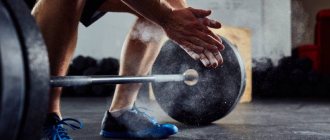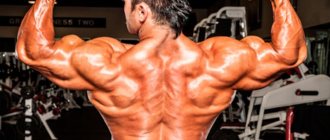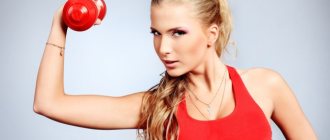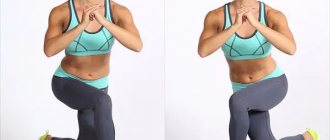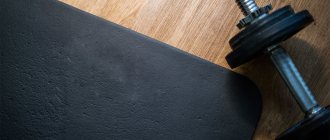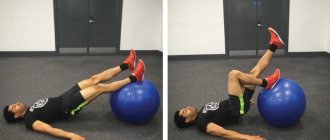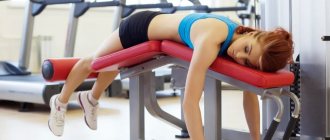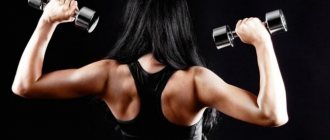Beautiful, toned arms not only add aesthetics to the entire look, but are also good physical strength. Most often, men do arm exercises in an effort to gain broad, defined muscles and the ability to lift more weight.
Girls mostly neglect these exercises, fearing significant changes in their figure. But they should also pay attention to such complexes, but do them less frequently and with less weight to lose weight in their arms. Then your hands will not become very large, but at the same time they will be beautiful and slender.
To develop such muscles, there are a large number of different sets of strength exercises for men and women. Classes can be done either with weights on machines or with dumbbells, or with your own body weight. Each athlete selects exercises that suit him.
Anatomical features and nuances of biceps training
The biceps is one of the most popular muscles among bodybuilders. It is located between the shoulder and elbow joints and consists of two parts. The long one is located on the outside, the short one on the inside, facing the body.
Because of its structure, the biceps is called the biceps muscle. The main movement for which it is responsible is bending the arm at the elbow. In addition, the biceps helps lift the arm forward and move it to the side.
The biceps muscle is large and strong enough that it does not require too frequent training. It is enough to devote 1-2 days a week to it. As your endurance increases, you can increase the number of approaches and workouts.
It is most effective to combine exercises to develop biceps with triceps. At the same time, you should perform the exercises until your hands become completely tired, until it becomes completely impossible to perform the action. Under such conditions, the biceps muscle develops and grows much better.
REVERSE GRIP PULL-UPS
EXERCISE TECHNIQUE - an exercise that does not require special equipment, to perform it you only need a horizontal bar, grab it with a reverse grip, pull yourself up to the level of your chin and slowly lower yourself, almost completely straightening your arms, leaving a slight tension in your biceps. Do not allow the body to swing, otherwise the amplitude will make the exercise easier and the biceps will receive less load.
TIPS - for those who can perform more than 12 times, hang a pancake on your belt, and for those who cannot pull yourself up, first put a stool, pull yourself up a little with your legs while standing on it, and lower yourself solely using your own body weight.
General training rules
The rules for training hands are no different from any other complexes. They are very simple and require compliance to achieve results.
Key points:
- Training should be regular . Long absences will be reflected in the absence of visible results.
- You need to exercise 1-2 times a week , performing 3 approaches to each complex.
- For each exercise, you need to perform at least eight repetitions , and for maximum effect, do it all the way.
- It is important to follow the execution technique . Do not make sudden movements, jerks, throw weights, do not jump from the horizontal bar or parallel bars.
- Before each workout you need to warm up.
- Gradually increase the weight or number of repetitions for bodyweight exercises. If the muscles get used to the load and do not feel its increase, then they will not grow.
The main points can be supplemented by the personal characteristics of each athlete’s training or the recommendations of the coach. All of them are required to be followed, as this not only guarantees beautiful muscles, but also prevents injuries during exercise.
Training on the horizontal bar
When you have this sports equipment in your yard or at home, doing pull-ups on it will be an excellent exercise for developing your biceps. Pull-ups can be done with either a reverse or direct grip. To get a noticeable result, you need to do at least three approaches. The number of repetitions in each approach varies from 10 to 15 times.
You should increase the load only when pull-ups begin to be easy. This can be done by placing additional weights on your feet or increasing the number of repetitions. To get the most out of pull-ups, keep your arms fully extended.
How to pump up your arms in the gym?
In order to pump up your arm muscles in the gym, you need to perform highly targeted strength exercises. If you follow the correct technique and load, just one lesson per week is enough.
After the muscles become more voluminous and prominent, the athlete will need to decide what he wants next. If you need to maintain the achieved result, then it is enough to continue exercising once a week, slightly increasing the load as you get used to it.
If you need to achieve greater results, then the number of workouts is increased to 2 times a week. In any case, pumped up arms will easily attract attention, and the body will look strong and athletic.
BENDING WITH TRX LOOPES
EXERCISE TECHNIQUE - a new direction in biceps training that appeared not so long ago, attach one side to a horizontal bar or crossover, and on the other side, install the handles at chest level, move the supports away to a distance of at least an outstretched arm and begin to perform biceps curls. The torso, legs and shoulders are fixed, only the biceps work.
TIPS – to make the exercise more difficult, during the biceps curl, position your body at a 45-degree angle, as shown in the photo, this will further train your core muscles.
Common reasons why arm muscles do not grow
Sometimes situations happen when you devote a lot of time to training, give it your all, but there is still no result. In this case, it is worth figuring out what is the reason for the lack of muscle mass gain.
Main reasons:
- Incorrect execution technique.
- Uniform loads.
- Maintaining the same weight.
- Plenty of rest between sets.
- Incorrectly selected training program.
- Poor nutrition.
- Lack of protein foods.
- Skipping workouts.
- Lack of motivation.
Any of these points may be the reason for the lack of visible results. You need to review all your actions and change or eliminate the wrong ones in order to achieve your goal.
Selection of optimal projectile weight
- If you can easily do the maximum number of repetitions required for a particular exercise, or even more, then you should increase the weight of the apparatus;
- If you are unable to get close to the lower limit in the number of reps required, then you are using too much weight. Reduce it and perform quality work with optimal weight;
- Add weight only if you can confidently perform the maximum number of repetitions required for a given exercise with the working weight. For example, if you did 8 reps on a 6kg dumbbell curl, then pick up the 8kg dumbbells and keep going.
If you can’t even do 4 repetitions with the new weight, then you obviously rushed to increase the weight, overestimating your capabilities. Go back to the old weight and work with it for a while.
There is nothing wrong with trying to lift more and more weight. The main thing is to do it wisely.
The best exercises for biceps
Arm workouts are divided into different parts, such as deltas, biceps, triceps and forearm. Each muscle group has its own separate complexes. Therefore, not all exercises with weights are suitable for biceps.
The best of them include:
- Lifting a barbell with a curved bar on a Scott bench.
- Hammer with alternate lifting.
- Raising the lower block in the simulator.
- Reverse grip pull-ups.
- Lifting dumbbells on an incline bench and standing overhead.
All of these complexes will help you build bigger biceps if you follow the correct technique and train regularly at least once a week.
Delta
The delta is a muscle located in the shoulder girdle area and is named due to its shape resembling a triangle. It is involved in flexing the shoulder and abducting the arm to the side. A developed delta visually makes the neck and shoulders wider.
Vertical barbell press
This exercise has several varieties that differ in the location of the athlete's body. The two main ways are:
- Standing, straight grip.
- Sitting from behind your head.
To properly master the technique, you need to understand each type of exercise separately:
- In the first case, the complex is performed in a vertical position, the barbell is held with a straight grip.
- This method of holding is more difficult than the reverse, so the training will be more effective.
- In this case, not only the biceps, but also the forearm are involved.
- Starting position for this exercise: feet shoulder-width apart, body tilted back, shoulders back.
- The barbell should be held with a straight grip at chest level, with your hands moving towards you.
- During the lift, the chin is tilted back and the bar moves straight up on a vertical axis.
- At the top point, the projectile is fixed with fully straightened arms exactly in the middle above the head, without deviating to one side.
- It is advisable to hold the bar so that in a straight position your arms are parallel.
- The load is chosen so that a minimum of 8 repetitions can be performed in each of the three approaches.
- In the second case, the athlete sits on a bench, his back is straight, the bar lies at shoulder level.
- The barbell is raised to the maximum point at which the elbows are straight, fixed and lowered, but not completely placed on the shoulders.
- The number of repetitions and approaches is similar to the first option.
Lifting weights through the sides
- There are also 2 ways to perform this exercise. The body can be positioned straight or tilted forward.
- In the first case, the athlete stands with his feet shoulder-width apart, his toes pointing to the sides, and his arms with dumbbells placed along his body.
- The weight needs to be lifted from the sides upward, first by slightly bending your arms at the elbows, straightening them at the end point.
- The dumbbells are lowered after the arms become parallel to the floor.
- In the second position, the athlete places his feet slightly wider than his shoulders, bends his knees slightly, moves his pelvis back and bends until his body is parallel to the floor.
- You need to take dumbbells in your straightened arms and lift them, spreading your arms out to the sides as much as possible.
- All movements should be smooth, the rise is made after inhaling, while the arms are slightly bent at the elbows.
- Both complexes should be performed 10 repetitions 3 times.
Seated dumbbell press
- The dumbbell press in this position is one of the basic exercises that involves several joints at once.
- It perfectly develops the front and side deltas. In terms of technique, this complex is very simple and does not require special preparation.
- To take the starting position, the athlete sits on a bench, preferably with a back support.
- Feet rest firmly on the floor, shoulder width apart. You need to take dumbbells with a regular grip and place them with their butts on your hips.
- After this, they rise to shoulder level, the hands turn away from themselves. From the starting position, the weight rises after inhaling until the arms are fully straightened.
- Upon reaching the top point, the position is fixed, and after exhaling, the dumbbells are lowered to the starting point.
- It is important to maintain clear, constant breathing. You need to perform 8 repetitions of 2-3 approaches.
Pull a weight to the chin with a straight grip
- The barbell will act as a load in this exercise.
- The chin pull involves the trapezius and deltoid muscles and is an extremely traumatic complex if the correct technique is not followed.
- To avoid injury, you need to stand in front of the barbell with your feet shoulder-width apart.
- An overhand grip is used that is slightly narrower than the normal hand position.
- Having taken the bar, you need to lift the projectile and hold it with straight arms at hip level.
- The back should be straight, shoulders down.
- In order to lift the barbell, you need to bend your elbows, moving them to the sides and up.
- In this case, you need to ensure that they are higher than your forearms.
- The lift is performed after inhaling until the bar reaches chin level.
- After this, you need to exhale and smoothly return to the starting position.
- This complex is performed in 3 sets, 6–8 repetitions each.
Raising the projectile in front of you to shoulder level
- To perform this complex, you can use both a barbell and dumbbells.
- The athlete stands straight, feet shoulder-width apart with toes slightly to the sides.
- When using a barbell, you need to take it with an overhand grip and hold it with straight arms at shoulder level.
- In the case of dumbbells, you can hold them either from above or with a hammer grip.
- To lift a load, your elbows need to be slightly rounded and your knees slightly bent.
- The arms move straight up in front of you and rise to the level of the chin or bridge of the nose.
- In the initial position, you inhale, and during execution, the breath is held until the top point.
- You need to lower it smoothly, after exhaling.
- It is important not to lock your elbows or swing or jerk while lifting.
- This complex is performed in 3 sets of 10–12 repetitions each.
Reverse breeding in the simulator
- This complex, performed using a special simulator, is considered isolating and is aimed at developing the deltoid muscles.
- If you select analogs, then it is similar to swinging dumbbells in an inclined position.
- During exercise, the athlete’s body is rigidly fixed on the bench, eliminating swinging.
- This adds to the effectiveness of this type of exercise.
- In the starting position, the athlete sits on a bench, facing the simulator and grabs special handles with his hands.
- After inhaling, you need to spread your arms as far as possible in different directions.
- The elbows should go behind the line of the back, and the shoulders should turn forward.
- After exhaling, the arms are brought back.
- This complex is performed in 3 approaches, 10 repetitions each.
Biceps
The biceps muscle is very strong and easy to train. Most often, athletes focus on its development, since the complexes are very simple and familiar to everyone.
For better results, it is important to increase not the frequency of training, but the number of repetitions and approaches. After exercise, the muscles should be as tired as possible. To do this, you need to perform basic effective complexes:
Curved barbell curl on a Scott bench
- Using a curved bar is considered safer when lifting the barbell towards you.
- The Scott bench is designed in such a way that the athlete sits on a special seat, resting on a stand tilted away from him, on which he places his hands with the apparatus.
- The bar should be held with a reverse grip directed towards you, not placing it on the bench, but holding it behind its surface in front of you.
- At the same time, the shoulders lie on it and are pressed against the entire surface.
- After exhaling, the arms bend at the elbows and pull the barbell towards the athlete. As you inhale, you need to lower the projectile back.
- The bench perfectly fixes a person, eliminating unnecessary swings and increasing the efficiency of loads.
- You need to perform 3 sets, 10–12 repetitions each.
Hammer with alternate lifting
- To perform this complex, dumbbells are used.
- The hammer grip perfectly develops the biceps and brachialis, and alternate execution increases the load.
- To take the starting position you need to stand straight.
- Feet are shoulder-width apart, arms are straight along the body and hold dumbbells.
- From this position, you need to alternately bend each arm at the elbow and raise it to the maximum point.
- At the same time, the wrist does not turn around, but is held as at the starting point.
- While lowering the first hand, the second one rises up, after which the movements alternate.
- You need to perform 10–12 lifts for each in three approaches.
Raising the lower block in the simulator
- This isolated exercise is aimed at developing only the biceps muscle and is performed in a special setup.
- It consists of a handle to which a cable is attached, passed through a block to facilitate movements.
- A weight is attached to its end, which creates force when pulling the handle.
- The athlete stands facing the simulator at a convenient close distance. You need to put your feet shoulder-width apart, straighten your back and grab the handle with a reverse grip.
- The arms should be slightly bent at the knees and placed along the body. At the count of times, the athlete exhales, holds his breath and bends his elbows, pressing his chest.
- On the count of two, the position is fixed and a breath is taken. At the last stage, the breath is held again, and the hands are lowered to the starting point and everything is repeated again.
- The movements are performed smoothly, but not slowly. You need to do 10-12 repetitions in each of the three repetitions.
Reverse grip pull-ups
- Pull-ups are one of the most popular and simplest arm exercises.
- It is performed using your own body weight and is accessible to almost everyone, since it does not require complex equipment, and horizontal bars are available in all courtyards and playgrounds.
- With a normal grip, the latissimus dorsi muscles will work more. But as soon as you change it to the opposite, the biceps comes into action.
- It is due to its action that the arms will bend and the entire body will lift.
- The athlete needs to go to the horizontal bar, grab it so that the wrists are facing him, and hang.
- You need to perform arm curls by working the biceps. Lifting occurs after inhalation, lowering after exhalation.
- The wider the grip, the more the latissimus dorsi muscles work. To connect the biceps to the work, you need to place your arms closer to each other.
- Jerking, swinging and jumping during classes are unacceptable.
- This may cause injury. You need to perform this exercise until your arms are completely tired, but at least 10 repetitions in each of the 3 approaches.
Triceps
This is the triceps brachii muscle. It is located on the back side and consists of three parts. It is involved in extension of the forearm at the elbow. When training your arms, you should not forget about this part and you need to pay special attention to it.
Many people advise combining triceps training with biceps, but most often they do not adhere to this theory and divide the training sets into 2 separate ones. To pump up your triceps you need to do the following exercises.
Push ups
Many types of push-ups are suitable for training the triceps. For example, such as ordinary from the floor, reverse from the bench, on uneven bars.
- To perform regular push-ups, the athlete assumes a position lying on all fours.
- Hands stand on open palms not very wide, feet on toes.
- By bending your arms at the elbows, the body lowers as low as possible to the floor, and then rises with force to the starting point.
- At the same time, neither the back nor the lower back bends.
- When doing reverse push-ups from the bench, you need to rest your palms on it behind your back. The legs stand on the feet with the knees bent or straight on the heels.
- The elbows bend and the body goes down, after which the arms are straightened with effort and the body rises again. At the same time, the elbows maintain their position and do not diverge to the sides.
- Dips are the hardest. The athlete hangs in the air, resting his straight arms on the bars.
- By bending the elbows, the whole body lowers down, leaning forward, and rises when straightening.
- The difficulty is that in this exercise there are only 2 support points, due to which the load increases. Push-ups should be performed at least 10 times in 2-3 approaches.
Close grip French bench press
- This exercise is one of the best for training triceps.
- It is isolating and loads all three parts of the triceps muscle.
- To perform it you will need a barbell and a bench.
- The athlete lies down on it, resting his feet on the floor.
- The mane is taken with a direct grip, raised above itself and pulled back slightly behind the head so as not to be perpendicular to the floor, but to create a slight angle.
- From the starting position, the arms are bent at the elbows to a right angle, without diverging to the sides, the bar is lowered to the level of the forehead and retracted slightly behind the head.
- The barbell is lifted by extending the arms.
- To increase the load, you can use an inclined bench rather than a straight one.
- It is more difficult to maintain balance on it.
- But first you need to hone your technique in simpler conditions. You need to perform 8-10 times in each of 3 approaches.
Forearm
Forearms definitely need to be trained. They affect arm endurance during other complexes, such as holding a barbell.
It consists of a large number of large and small muscles that work together to flex and extend the elbow and wrist. To train them you need to do:
Lifting the barbell with a reverse grip
- The technique for performing this complex is very simple and does not require special skills.
- In the starting position the athlete stands straight.
- Feet shoulder-width apart, toes pointing outward, shoulders down, eyes looking straight ahead.
- The barbell is held with a reverse grip on straight arms parallel to each other at hip level.
- To perform the movement, the arms bend at the elbows, lifting the barbell.
- The maximum point of lift is reached at the moment when the forearms become parallel to the floor.
- The shoulders are not involved in the exercise.
- They maintain the same position throughout the workout.
- This complex must be repeated 10 times in each of three approaches.
Hammer bend
- This type of workout is a basic exercise for the arms.
- It got its name because of the similarity of holding a dumbbell with a hammer.
- To perform the complex, the athlete takes the starting position.
- You need to stand straight, feet shoulder-width apart.
- The arms are straight along the body and hold dumbbells.
- From this position, the elbows bend and the arms with the apparatus are alternately raised until the floor and forearm are parallel.
- The wrist does not turn, but remains in the initial position, the thumb will be on top at the top point, and the dumbbell will be facing the floor.
- Such lifts should be performed at least 10 times per arm in each of 2-3 approaches.
Flexion-extension with weight at the wrists
- This exercise is performed while sitting on a bench.
- Hands are placed with the outside of the forearms on your knees.
- The hands hold the bar suspended behind the knee line so that the fingers point upward.
- In this position, you need to straighten your wrist, lowering the bar down and bend it again, raising the barbell.
- To avoid helping yourself with your legs, the complex can be performed with your hands directly on the bench.
- The weight is chosen so that you can perform 3 approaches in each of which at least 7-8 repetitions.
Expander stretching
- An expander is an elastic exercise machine that can have 2 handles or consist of only one elastic band.
- To stretch it, you need to make an effort, due to which the training is carried out.
- To work the forearm, the expander is held in two hands at chest level.
- To perform the movement, the arms are spread to the sides as much as possible, and the expander is fixed for a couple of seconds in a tense position.
- Then you need to return to the starting position and repeat the action.
- This complex is performed in 3 sets of at least 12–15 repetitions each.
A well-designed arm training program, covering all muscle groups and following all the rules and techniques, will definitely help you achieve a beautiful, sculpted body.
To do this, you just need not to feel sorry for yourself and constantly increase the load as your body gets used to it and pay special attention to proper lifestyle and nutrition. If your body gets enough rest and protein, your muscles will grow much faster.
Alexandrova Anastasia
Nutrition and healthy lifestyle specialist and author of myfitnesblog.com. For many years, she has successfully helped women and men lose weight and maintain a beautiful figure.
Superset: extension of the arms on a block from behind the head + bending of the arms on a block to the chest
These exercises are aimed at pumping both biceps and triceps.
Extension of arms on a block from behind the head
To perform this exercise you will need a curved handle.
Technique:
- We stand with our backs to the crossover block. The body is slightly tilted forward to make it easier to maintain balance.
- Grab the handle and straighten both arms up above your head.
- We return them to their original position, bending them at the elbows.
- The body is slightly tilted forward to make it easier to maintain balance.
- We perform the exercise without inertia.
How to properly perform basic exercises with a barbell
Is it possible to pump up using small weights?


